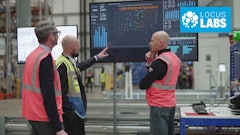
From the recent East and Gulf coast strikes to worker shortages, supply chain disruptions are everywhere. Yet despite being a foundational element of a resilient supply chain, worker safety is often overlooked by business leaders.
Unsafe working conditions are a key driver of strikes, protests and other costly delays. When safety is not embedded in how we work, supply chains crumble. Operationalizing safety starts with meaningful frontline worker engagement and communication.
Break the Silence: Encourage Safety Conversations
According to the American Society of Safety Engineers, only 40% of workers feel comfortable speaking up about an unsafe act or condition on the job. This data speaks to a fear of retaliation plagues the workforce. And considering that the sooner workers can identify potential risks and hazards, the easier they are to resolve, this reality is quite concerning. Effectively creating an environment where workers feel safe and comfortable to voice their concerns is crucial to preventing worker injuries and maintaining steady operations across supply chains. Open communication leads to transparency and trust across the entire organization, from frontline workers to the executive level.
When leaders show they are taking reported concern seriously by acting quickly and closing the loop on open items, workers are more likely to continue reporting potential hazards and reinforce the organization’s safety protocols. This not only helps avoid accidents but also builds trust among workers, making them more likely to share feedback in the future.
Facilitating this level of interaction with the front line requires technology. Simple-to-use technology purpose fit for the frontline is a critical component of ensuring workers have an easy way to report incidents or relay safety information at the click of a button– and makes it easier for supply chain leaders to act on reports and follow up on the resulting outcome.
Engage and Empower: Build a Safety-Driven Supply Chain
A collaborative safety culture isn't just about agreeing on an organization’s rules and protocols— it's about encouraging workers to actively participate and take ownership in setting the standard for what safety looks like. Vector’s State of Industrial Worker Safety and Well-Being report revealed 83% of employees feel safety protocols are merely checkboxes at their organizations. This signals leaders clearly have room for improvement when it comes to encouraging workers to foster a safe work environment. When workers feel empowered to participate in creating a strong safety culture, it can prevent small issues from spiraling into major disruptions.
To foster an engaged workforce, supply chain leaders need to build a culture where safety is a shared responsibility, and all voices are valued. This means leveraging technology that can help an organization embed safety policies in existing workflows and procedures. Engaged workers are more proactive, focused and committed to their work, ultimately preventing disruptions like halted production or delayed shipments.
Steps for a Safe and Resilient Supply Chain
When it comes to supply chain resilience, safety-driven communication and collaboration play a pivotal role in proactive preparation. Instead of reacting after the fact to labor unrest and work stoppages due to unsafe working conditions, leaders can avoid many of these disruptions by addressing safety concerns head-on.
- Start by empowering your organization’s frontline workers: Leverage technology to create messaging and channels where workers can easily and anonymously report safety concerns in real-time. Ensure there’s a clear process, with no potential setbacks like language barriers, for addressing these issues and following up on resolutions.
- Train your leaders to listen to their frontline workers: Leaders should not only encourage open communication but also actively seek it out in meetings or during worksite visits. Regular check-ins with frontline workers can help identify safety risks before they escalate and build a sense of trust across different levels.
- Integrate positive feedback loops: Establish positive feedback loops where leaders not only acknowledge safety reports and concerns from workers but actually integrate these reports into daily operations. Workers must know that their feedback is valuable and taken into consideration. Technology can automate and simplify much of this by providing each stakeholder with relevant information and insights. Operational leaders are able to make informed decisions on where and with whom to spend valuable time.
When leaders place safety at the forefront of the organization’s operations and values, it drastically enhances supply chain resilience in the face of disruption. A safety-first environment doesn't just protect workers, it ensures smooth and uninterrupted operations.
Ahead of the Game: Leveraging Safety for a Resilient Future
Building a resilient supply chain requires that organizations operationalize safety where risks are inherently mitigated in the course of day-to-day work. Fostering and facilitating open communication is key so that your frontline workers are engaged and aligned each and every day. When workers feel comfortable sharing their concerns and are actively engaged in maintaining a safe work environment, the entire supply chain benefits.
Supply chain leaders who prioritize safety and open communication across the organization will experience fewer disruptions, smoother operations and long-term supply chain resilience. Safer operations are more productive operations. As businesses look toward the future and into 2025, adopting open safety-driven communication strategies is essential to navigating the ever-changing and turbulent supply chain landscape.



















